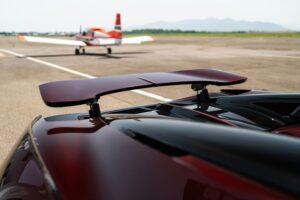Bugatti demands nothing less than perfection from each example of its Bugatti W16 Mistral, which undergoes an exhaustive and uncompromising quality assessment process before it is delivered to its owner. At the heart of the testing exercise lies a protocol that subjects each vehicle to a minimum of 400km of evaluation across the diverse landscapes of Alsace, ensuring that every example meets the high standards of the marque.
A 350km test route through the picturesque Alsatian countryside serves as an amphitheater for evaluating the W16 Mistral’s capabilities. On the carefully curated route, every component undergoes individual testing, taking the fit, feel and functionality of features within the cockpit, as well as the precision of the steering system’s response and return characteristics, into consideration.
A route designed to challenge: open road testing
The route includes traditional Alsatian villages, winding country roads that test the W16 Mistral’s agility, long highway stretches intended to evaluate stability and comfort during sustained cruising, and mountain passes that challenge the powertrain under a range of elevation and atmospheric conditions.

Bugatti has carefully selected the route to reflect the full spectrum of real-world scenarios a customer may encounter to test the driving experience. This includes the technical challenge of cobblestone surfaces that can reveal the slightest chassis irregularity, to open stretches where the W16 engine can reach its crescendo in the open-air cockpit.
Testing beyond functionality
The validation process extends beyond mechanical systems and encompasses the complete sensory experience. Noise testing occurs across multiple scenarios including evaluation with and without the soft-top roof, analysis of wind and road noise characteristics, assessment of the exhaust system’s acoustic signature and verification of chassis and tire rolling dynamics.
Transmission behavior also receives dedicated attention, with technicians analyzing gear changes during acceleration, deceleration and varying load conditions. Every part of the surrounding environment is used in the pursuit of perfection, including the narrow streets lined with ancient stone buildings, which create natural acoustic chambers for Bugatti’s test drivers, using the echo against walls to analyze every nuance of the vehicle’s sound profile.
Three qualified specialists
Only a select few specialists take on the mantle of such a rigorous assessment journey. Currently, only three experts possess the full qualification and dedication required to conduct W16 Mistral quality appraisal. These evaluators together represent decades of accumulated knowledge, with each new test driver undergoing an intensive training regime, including several supervised test drives alongside senior experts and fully autonomous assessments encompassing comprehensive sensory analysis.

This human-centric approach reflects Bugatti’s fundamental methodology: 90% of quality validation is derived from the driver’s personal analysis and sensory interpretation through sight, sound and touch. The three automotive specialists possess the ability to detect the slightest irregular sound, identifying unknown vibrations often imperceptible to untrained senses. These are sounds that could indicate developing issues. Their mechanical understanding enables accurate detection and diagnosis of an anomaly early on.
Each observation is meticulously recorded via a dictaphone during the drive for a follow up in-depth analysis, and when necessary, followed by partial or complete vehicle disassembly. The remaining 10% of the evaluation uses electronic diagnostics – a combination of Bugatti’s internal telemetry systems and data loggers are used to continuously monitor and record all performance metrics throughout the test drive.
The circuit arena: closed-road testing
Moving from the open road to a closed-circuit arena, the testing program culminates with high-speed track sessions at the Colmar airfield, where Bugatti maintains an exclusive 1,600m partnership facility. At this site, emergency braking systems, electronic stability program (ESP) and anti-lock braking system (ABS) undergo evaluation at speeds reaching 300km/h.

For this, the Mistral’s removable roof mechanism demands additional layers of testing. Every aspect of the roof’s fit, removal process and high-speed resistance undergoes scrutiny. Only with the roof removed can the roadster achieve its top speed, enabling the quad-turbocharged W16’s 1,600ps to express itself without constraint.
The iterative nature of Bugatti’s assessment method is designed to ensure absolute perfection. Following the identification and resolution of any irregularities, regardless of how minor, a secondary verification test of typically 50km or more is conducted to confirm whether the corrections made have been effective. This process repeats as many times as necessary until the vehicle demonstrates what Bugatti deems a flawless performance, under every conceivable condition.
This article was first published on Bugatti.com
In related news, Peter Gillet, founder of Marketpoint Recall, discusses why OEMs need QA that anticipates failures


